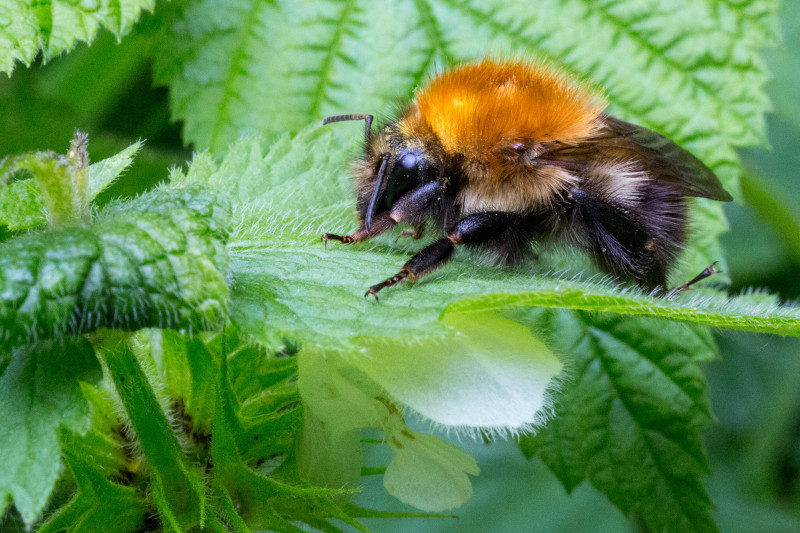
Tree Bumblebee Facts
- This very beautiful Arthropod is most typically referred to by the common name of the Tree Bumblebee across the entirety of its native range. The small insect does have at least one other general title, though. That’s the somewhat intriguing term of new garden bumblebee.
- Inside of the scientific community, however, the delicate creature perhaps more frequently goes by yet another tag. Fortunately, that’s a relatively simple one for the layperson to pronounce, as such go. That’s because it holds the technical moniker Bombus hypnorum.
- The invertebrate received that specific designation due to the efforts of Carl Linnaeus himself. The highly esteemed Swedish researcher accomplished the first recognition of it as a separate and distinct species. He managed that scientifically noteworthy deed in the year 1758.
- It’s possibly most well known among entomologists due to one particular evolutionary pattern. The small animal generally chooses to inhabit regions that most others of its kind typically avoid. The bumblebee thus fills an environmental niche that would otherwise be vacant.
- Fortunately, the amazing Tree Bumblebee appears to be maintaining a population base that’s both stable and sufficient. That pleasant state also seems to hold true throughut its territory. The IUCN therefore presently lists it as Least Concern on its Red List of Thretened Species.
- The wonder of Nature nevertheless still faces several potential threats to its continued existence as a species. In this, it’s simply following a sad pattern now common to all life on this planet. It’s now facing the perils posed by habitat loss and ongoing climate change.
Related Articles
Tree Bumblebee Physical Description
The remarkable Tree Bumblebee typically draws attention from those individuals fortunate enough to notice one in the wild. Like most of its kindred around the world, however, it usually does so for its appearance more than for size. Yet, in this manner, it distinguishes itself extremely well.
As with virtually all known bees, the insect displays a different type of the physiological characteristic known as sexual dimorphism. The species also evolved as divided into three castes. Queens develop as larger than males or workers. In fact, the difference is often quite noticeable.
The mighty queens of each colony achieve the greatest physical dimensions, by far. This trait varies, sometimes greatly, among individuals, though. But, overall, these average a total body length of approximately 0.63 – 0.87 in (1.6 – 2.2 cm). Though rare, some examples exceed even this.
Members of the worker class, however, generally evolved to remain much smaller. Individuals of this class only reach mean lengths measuring about 0.4 – 0.47 in (1.0 – 1.2 cm). Males, meanwhile, also vary in size, but generally achieve dimensions slightly greater than that of the workers.
Other differences serve to further distinguish the differing social castes of the amazing Tree Bumblebee. The males, for one, display a significantly chunkier shape than the others. Queens and drones, however, have sharper ends to their abdomens, as well as somewhat shorter antennae.
Yet, it’s the stunning coloring of this insect that usually most catches the eye. The thorax of the species presents a covering of hair with a gorgeous ginger shade. Its abdomen, though, displays black hair. But, that on the tail manifests a dazzling white hue, making for an amazing contrast.
- Kingdom: Animalia
- Phylum: Arthropoda
- Class: Insecta
- Order: Hymenoptera
- Family: Apidae
- Genus: Bombus
- Species: B. hypnorum
Tree Bumblebee Distribution, Habitat, and Ecology
The visually appealing Tree Bumblebee evolved as native to a relatively large expanse of the surface of the earth. The full extent of that zone of habitation, in fact, might surprise some people. That’s true since this natural wonder developed as endemic to most of Europe and northern Asia.
On the European continent, the biological marvel natively inhabits only the continental regions. That natural territorial range additionally reaches as far north as northern France. Elsewhere, though, the creature developed natively as far east as the Kamchatka Peninsula, in Russia.
The awesome product of evolution displays decidedly unique preferences regarding where it chooses to live. These habitat zones all lie within temperate climates, to be certain, however. Yet, within these conditions, the bumblebee makes its home in a range of truly surprising locations.
The bee most frequently appears in forests, usually deciduous one’s. In those regions where trees don’t appear in abundance, though, it tends to seek out an unusual alternative. In such settings, it resides in human residences! There, it makes its nest in almost any available hole it can find.
Workers of the amazing Tree Bumblebee forage for vital pollen and nectar. Once acquired, they return with this to the nest. Intriguingly, the species seems to be especially attracted to various plants with downward-facing blooms, like comfrey. Yet, it does also visit other plants as well.
It’s generally observed between the months of March and July, but sometimes does remain active for longer periods of time. Individuals are also extremely active, moving rapidly from plant to plant. Nest size always varies, of course, but rarely exceeds more than a few hundred individuals.
Species Sharing Its Range
Check out our other articles on 4 Charming Christmas Season Species, Marbled Polecat, Okefenokee Swamp, Appalachian Avens, Hallowen Hermit Crab, Koa Butterfly, Anegada ground iguana
